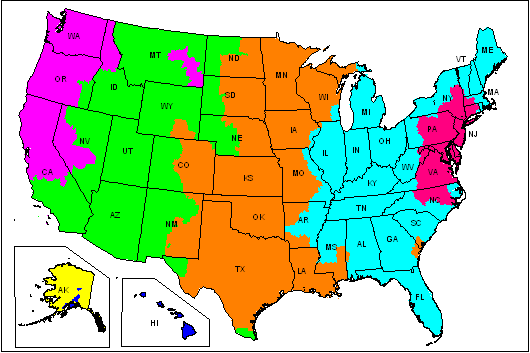We heard about the improvements weeks ago, but details in the form of destination actual zip codes where the improvements were made were hard to come by. Ground service maps were updated at the FedEx website and are now available.
Marked improvements were noted over most of the network. From the Washington, DC area (where PA & Associates is headquartered), FedEx dropped a day of transit time to key markets such as portions of KY, TN, MS (previously a 3-day transit time). FedEx now reaches nearly the entire state of GA, with the exception of the Savannah region, within two days. Alabama, which previously had an almost equal coverage of half of the state at two days and half at three days, now is almost entirely two days.
But the big story is FL. Previous to August, any ground shipment destined anywhere in the state would have taken three days. Now every delivery zip code in the state is a two day delivery.
ND, MT and portions of WY also dropped a day, moving from a five day deliver to four days, as did a portion of NM.
FedEx made steady improvements over the years in getting to CA more quickly. In this iteration, CA transit times did not change. The next day ground destinations also remained unchanged. The improvements are readily visible in the maps below. Dark pink indicates next day ground from the Baltimore/Washington area, turquoise shows two-day, orange three-day, green four-day and fuchsia indicates five-day delivery.
 |
| FedEx Ground Delivery Map as of July, 2010 |
 |
| FedEx Ground Delivery Map as of August, 2010 |
While shaving a day from transit times might not seem like a big deal to the infrequent user of parcel services or even to the consumer, consider this scenario:
E-commerce operations are under considerable pressure to offer promotions for free shipping. Nobody is in business to lose money and e-tailers are no exception. There was a time when the profit earned on shipping was three times (or more) greater than the profit in the product being shipped. Consumer evaluation of the cost of shipping in addition to the product price has narrowed the margin available on shipping. This has led to the common practice of allowing online shoppers to "upgrade" their shipping method to receive products more quickly. Typically, this is positioned on the e-commerce site as an upgrade to express or "air" shipping (at UPS, the branded services are Next Day Air, Next Day Air Saver, 2nd Day Air and Three Day Select. FedEx uses Priority Overnight, Standard Overnight, Two Day and Express Saver).
A good e-tailer with a basic Transportation Management System can manage this upgrade to put them back into the glory days of profit-center shipping. An upgrade to Two Day Air, for example, might mean an increase in the charges to their customer of $15 or more.
I just tried this at Goldman Brothers website. I put a pair of Under Armour shorts and polo shirt into my cart and proceeded to the check out. My cart total qualified me for free shipping ($59 or more). Goldman Brothers is located in NY, so that would actually get to me in one day by Ground service. However, you would never tell the consumer that! According to their website, I saved $7.61; their rate to move my new apparel to me via Ground service.
Let's say I really wanted those items here by the weekend because I had tickets to the Baltimore Orioles and it was going to be hot this weekend (tickets are easy to come by for an O's game these days). So I'd better upgrade my shipping to the two-day option for $17.19. A TMS could compare the destination to the ground delivery commitment schedule and determine that Ground service would suffice to meet my delivery demand. However, I just paid for 2nd Day Air. Who cares? I got my package when I expected it and the e-tailer just pocketed the difference. Everyone's happy, right? In fairness to Goldman Brothers, they state they use UPS to ship to consumers. Although they still benefit from this scenario, the improvements which are the subject of this post have to do with two-day delivery points on FedEx. Still, FedEx just created an opportunity for some of the more savvy shippers to line their pockets and no one will be the wiser.
What's next at FedEx? We're hearing rumblings that something big is coming this Fall regarding LTL services.








